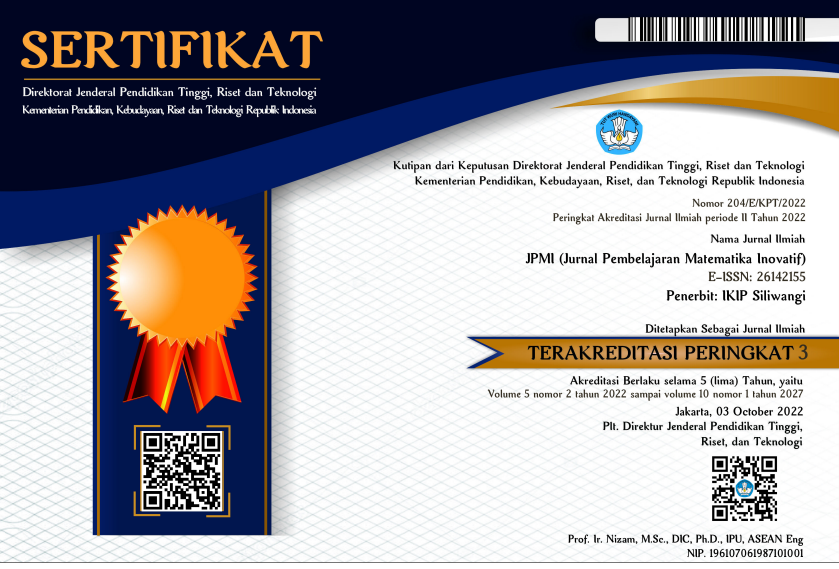KEMAMPUAN PEMECAHAN MASALAH MATEMATIKA SISWA SMK MATERI MATRIKS DITINJAU DARI GAYA KOGNITIF ADAPTASI DAN INOVASI
DOI:
https://doi.org/10.22460/jpmi.v6i2.15869Keywords:
Problem Solving Abilities, Matrix, Cognitive StyleAbstract
In this research, the authors investigated difference in the mathematical problem-solving abilities of students at SMKN 1 Grati Pasuruan, in terms of the cognitive style of adaptation and innovation of class XI. Data collection was carried out by giving an Adaptation-Innovation in Workplace s (AI-W) questionnaire to determine students' cognitive styles and the Matrix Problem Solving Task (TPMM) to measure the mathematical problem solving abilities. Data collection is used to obtain relevant and accurate data. The methods used for data analysis techniques are questionnaires, tests, and interviews. In this study, students with an adaptive cognitive style were able to fulfill three of five indicators of solving mathematical problems, while subjects with an innovative cognitive style were able to fulfill four of them. The results of this research indicated that students in the innovation group performed better than the adaptation group. Overall, these results provide a more detail description of individual differences in the math problem-solving abilities of SMK students on the matrix.
References
Badjeber, R., & Mailili, W. H. (2018). Analisis Pengetahuan Prosedural Siswa Kelas Smp Pada Materi Sistem Persamaan Linear Dua Variabel Ditinjau Dari Gaya Kognitif. Jurnal Penelitian Dan Pembelajaran Matematika, 11(2), 41–54. https://doi.org/10.30870/jppm.v11i2.3753
M.J.Kirton. (2011). Adaption-Innovation In the Context of Diversity and Change. In Nucl. Phys. (Vol. 13, Issue 1).
Michael, M. G. (2018). Problem Solving, Decision Making, and Kirton Adaption-Innovation Theory in High-Performance Organizations. Walden Dissertations and Doctoral Studies. http://search.ebscohost.com/login.aspx?direct=true&db=psyh&AN=2018-13261-096&site=ehost-live
Muhammad Darwis, J. H. U. (2015). Efektivitas Penerapan Model Berbasis Masalah Setting Kooperatif Dengan Pendekatan Saintifik Dalam Pembelajaran Matematika Di Kelas X Sma Negeri 11 Makassar. Jurnal Daya Matematis, 3(1), 30. https://doi.org/10.26858/jds.v3i1.1314
NCTM, (The National Council of Teachers of Mathematics). (2000). Principles and Standards for School Mathematics. In NCTM (Vol. 13, Issue 1).
Nurmutia, H. E. (2019). Pengaruh Gaya Kognitif Terhadap Kemampuan Pemecahan Masalah Matematis Siswa. Edumatika: Jurnal Riset Pendidikan Matematika, 2(2), 98. https://doi.org/10.32939/ejrpm.v2i2.443
Permendikbud. (2018a). Peraturan Menteri Pendidikan dan Kebudayaan RI Nomor 34, Tahun 2018, tentang Standar Nasional Pendidikan SMK/MAK. In MENTERI PENDIDIKAN DAN KEBUDAYAAN REPUBLIK INDONESIA (Vol. 8, Issue 1).
Permendikbud. (2018b). Permendikbud RI Nomor 37 tahun 2018 tentang Perubahan atas Peraturan Menteri Pendidikan dan Kebudayaan Nomor 24 tahun 2016 tentang Kompetensi Inti dan Kompetensi Dasar Pelajaran pada Kurikulum 2013 pada Pendidikan Dasar dan Pendidikan Menengah. JDIH Kemendikbud, 2025, 1–527.
PISA, O. (2019). PISA 2018 Assessment and Analytical Framework. In OECD Publishing. https://doi.org/10.1787/b25efab8-en
Rosita, N. T. (2013). Pendekatan Pembelajaran Matematik Untuk Meningkatkan Kemampuan Pemecahan Masalah Matematis Siswa SD. Seminar Nasional Matematika Dan Pendidikan Matematika, November, 59.
Septyanggraeni, A. D. (2020). Jurnal Inovasi Pendidikan Matematika Upaya Meningkatkan Kemampuan Menyelesaikan Masalah Matematika Melalui Guided Discovery Learning Menggunakan Microsoft Teams Berbantuan Excel Postulat : Jurnal Inovasi Pendidikan Matematika PENDAHULUAN Adanya pandemi CO. 1, 98–108.
Siswono, T. Y. E. (2009). Pengembangan Model Pembelajaran Matematika Berbasis Pengajuan dan Pemecahan Masalah Untuk Meningkatkan Kemampuan Berpikir Kreatif Siswa. Makalah Simposium Pusat Penelitian Kebijakan Dan Inovasi Pendidikan Badan Penelitian Dan Pengembangan Departemen Pendidikan Nasional, 021, 10002.
Suprapto. (2015). Indonesian Digital Journal of Mathematics dnd Education. Journal of Mathematics and Education, 2(3).
Trizulfianto, T., Anggreini, D., & Waluyo, A. (2017). Analisis Kesulitan Siswa Dalam Memecahkan Masalah Matematika Materi Program Linier Berdasarkan Gaya Belajar Siswa. UNION: Jurnal Ilmiah Pendidikan Matematika, 5(2). https://doi.org/10.30738/.v5i2.1229
Ulya, H. (2015). Hubungan Gaya Kognitif Dengan Kemampuan Pemecahan Masalah Matematika Siswa. Jurnal Konseling Gusjigang, 1(2). https://doi.org/10.24176/jkg.v1i2.410
Yimer, A., & Ellerton, N. F. (2009). A five-phase model for mathematical problem solving: Identifying synergies in pre-service-teachers’ metacognitive and cognitive actions. ZDM - International Journal on Mathematics Education, 42(2), 245–261. https://doi.org/10.1007/s11858-009-0223-3

















